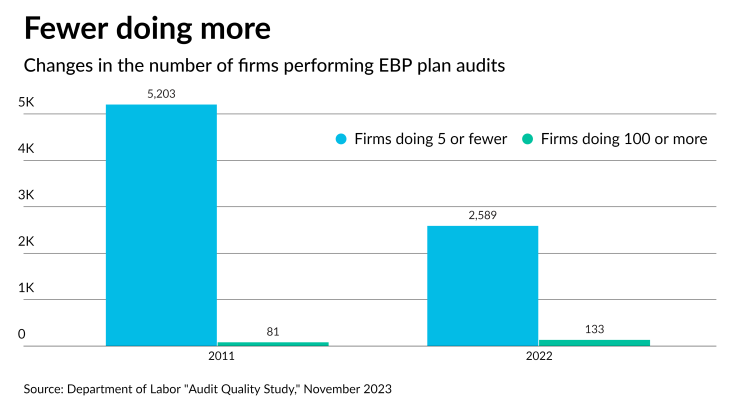Almost a third (30%) of employee benefit plan audits have major deficiencies, according to a recent report from the Department of Labor — but that actually represents an improvement.
The most recent
"This puts $927 billion and 11.7 million plan participants and beneficiaries at risk, an increase of $274 billion compared with prior EBSA studies," the report said, though it also pointed out that significantly fewer plan participants were at risk — they were down by almost half, from 22.5 million in 2015.
The report noted that the DOL has been collaborating with auditors, the American Institute of CPAs, the Financial Accounting Standards Board, the Public Company Accounting Oversight Board and others on improving EBP audits, working to update standards, develop and share best practices, identify underperforming auditors, and more.
"We found that there continues to be a clear link between the number of employee benefit plan audits a CPA performed and the quality of the audit work," the report noted.

On that front, the current report offers some positive news: While there has been a 7% increase in the number of EBP audits, there has been a 40% decrease in the number of CPA firms performing audits, and the vast majority of that decline has been among firms that performed five or fewer audits.
"The number of folks who do five or fewer audits is down 50% from 2011, and that's great — so long as those folks are making a business decision," Carl Mayes, the vice president of audit & accounting quality at the AICPA, told Accounting Today. "We've always encouraged practitioners to either invest in training and methodologies to do high-quality work, or to focus on developing the necessary competencies, and what we're hearing from practitioners is that folks are getting out of this area for that reason."
Room for improvement
Overall, Mayes saw positive signs in the OCA's findings.
"We would term it 'progress with more work to do,' he said. "That's a fair way to look at the report. … And especially when you dig into the underlying data, you see we're moving in the right direction."
For instance, the number of engagements with multiple deficiencies has dropped significantly from 2015 — 62% of audits had five or more deficiencies then, versus only 9% this time around.
And while there had been a major gap between the ability of OCA investigators to spot problems and that of the profession's peer reviewers to detect them — peer reviews found only 5% of audits had deficiencies in 2015 — they are now on par, according to this year's report.
"That was a serious problem," Mayes noted, "but this time, peer review found the exact same percentage of audits with nonconformities. … That's a huge win for our self-regulatory regime."
What's more, he added, "As we're catching those folks, we know our remedial efforts work. It's about getting good quality remediation, and focusing on the subject matter areas where they're having the most trouble."
Both Mayes and the OCA pointed out that members of the AICPA's Employee Benefit Plan Audit Quality Center had significantly lower deficiency rates.
"That's testimony to the resources we've put into that, and to those firms' commitment to quality in their practices," Mayes said.
Going forward, he doesn't see a single major area of focus for improving EBP audits. "Last time, there was clearly a challenge around low-volume auditors," he said. "This time, it's going to be a handful of areas. It's less about things we need to repair and remedy, versus there are areas that we need to emphasize more."
Among the primary areas to focus on for improvement, he suggested, are contributions, benefits payments and participant data testing.
"There are opportunities to really key in on the areas where we're seeing the most issues," he said.
Besides recommending members in the Benefit Plan Audit Quality Center, he also said the AICPA plans to release a course in the spring that covers the major issues discussed in the DOL report.
The new OCA study looked at 307 Form 5500 filings and the related audit reports and workpapers from the 2020 form year, which was the last year before a new standard, SAS 136, "Forming an Opinion and Reporting on Financial Statements on Employee Benefit Plans Subject to ERISA," was implemented, making comparisons difficult.
The OCA's three previous EPB studies were released in 1997, 2004 and 2015.




